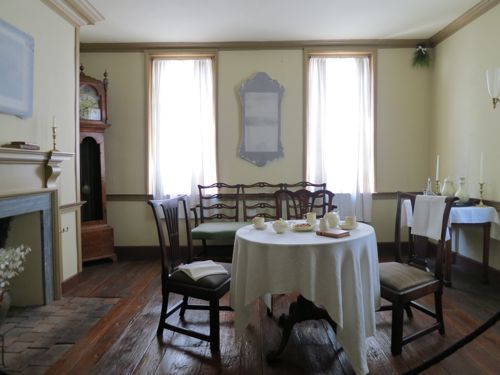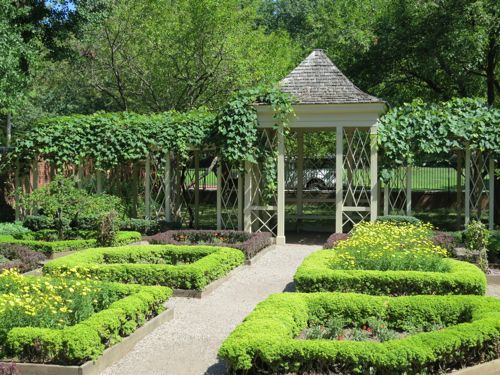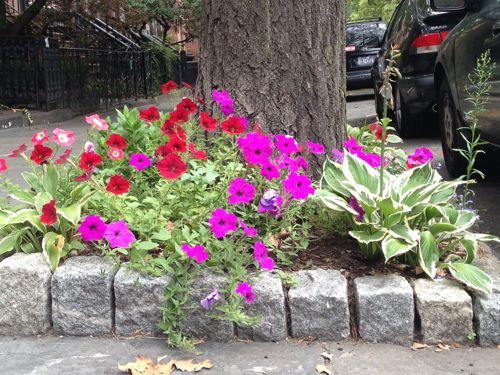
LAST WEEK, I FINALLY ACHIEVED ENTRY into a pair of restored 18th century houses in Philadelphia that had eluded me for years. The modest 1776 Todd house, above on left, and the elegant 1786 home of Bishop William White are on the same block in Center City, Walnut Street between 3rd and 4th. They’ve always been closed when I’ve tried to visit in the past. They’re only open in the summer months; sometimes they’re understaffed; they only allow 10 at a time inside; you call for information and can’t get through — so a certain mystique had built up for me around these sites. Then there’s the ticketing rigamarole: you have to first pick up a (free) ticket at the Visitor Center at Independence National Historical Park, a few blocks away at Market and 6th, and sign up for a scheduled half-hour tour, which happen once or twice a day.
On Friday morning, however, I did it. Five showed up for the tour, including people from Missouri and Washington State. First we visited the middle class house where John Todd, a Quaker lawyer, his wife Dolley Payne Todd, and their two children lived (with just a single servant). It’s very much a Philadelphia row house of the late 18th century, with narrow twisting wooden stairs, a tiny kitchen, a dining room and parlor, small bedrooms, and an office in a prime corner where Todd practiced law. He died here in the yellow fever epidemic of 1793, as did 4,000 other Philadelphians , including one of their young sons. Dolley went on to meet another young lawyer, James Madison, in that very house two months later, and eventually became the 4th First Lady of the U.S. The house is furnished with period pieces, though they’re not original to the house — and well done as the restoration is, it is just a warm-up for the Federal-style Bishop White house a few doors down.

Above: The side of the Todd house is more impressive than the front, which is only two windows wide. We entered through a door behind the picket fence.



From top: kitchen, dining, study in Todd house.

The 4-inch-wide door to the left of the stairs is a candle closet(!)

Above: Fire buckets hang from the ceiling in the Todd house.
 When Kevin O’Neill, the National Park Service ranger who led the tour, opened the fanlight door to the Bishop White House, left, we all gasped. It is grand, especially by comparison to the Todd house: the plaster archway in the front hall, the diamond-patterned floor cloth, the wide stair landings and turned balusters, the painstakingly reproduced Scalamandre (or did he say Schumacher?) wallpapers in every room. This house is filled almost exclusively with furnishings that belonged to the original homeowner, a bishop in the Protestant Episcopal Church just around the corner. The artifacts were rounded up in the late 1940s and ’50s from as far away as Texas and South Africa; they’d been sold off after the Bishop’s death in 1836, but their provenance was apparently traceable down to the silver and china. The Bishop had 11 children and quite a few servants; Washington, Jefferson and Franklin were among the elite guests. He seems to have been an admirable guy — an abolitionist, of an ecumenical bent (rabbis dined here as well), a charitable fellow who never turned a beggar away empty-handed from his door, the story goes.
When Kevin O’Neill, the National Park Service ranger who led the tour, opened the fanlight door to the Bishop White House, left, we all gasped. It is grand, especially by comparison to the Todd house: the plaster archway in the front hall, the diamond-patterned floor cloth, the wide stair landings and turned balusters, the painstakingly reproduced Scalamandre (or did he say Schumacher?) wallpapers in every room. This house is filled almost exclusively with furnishings that belonged to the original homeowner, a bishop in the Protestant Episcopal Church just around the corner. The artifacts were rounded up in the late 1940s and ’50s from as far away as Texas and South Africa; they’d been sold off after the Bishop’s death in 1836, but their provenance was apparently traceable down to the silver and china. The Bishop had 11 children and quite a few servants; Washington, Jefferson and Franklin were among the elite guests. He seems to have been an admirable guy — an abolitionist, of an ecumenical bent (rabbis dined here as well), a charitable fellow who never turned a beggar away empty-handed from his door, the story goes.


Above: The very wallpaper patterns in place in the late 18th/early 19th centuries.




The painting propped on a stand, above, commissioned by one of the Bishop’s children shortly after his death, is of this second-floor study. It greatly enabled an accurate re-creation of the room, even after the house had been occupied by an insurance company for decades (happily, they did no damage to the house’s architectural integrity).

Above: The Park Ranger peering down the hall to where I was lagging behind to take a picture. He’s hoping I’m not some kind of stealth graffiti artist, or perhaps just anxious to keep to his schedule.

Above: All the mod cons in a room at the back of the hall — from here straight into an alley that ran behind the house.

Above: A kitchen much larger than those in other houses of this period. Below: The Bishop’s mosquito-netted bed.

Some of the Ranger’s statements were questionable, such as that Philly went into decline after the 1790s (when the nation’s capital was moved to D.C. and the founders, who had gathered there as a central point while the Constitution was being written and the nation formed, repaired back to their Virginia plantations and homes elsewhere), and that the city’s reputation and vitality didn’t return until the Bicentennial of 1976. Huh? What about the Industrial Revolution? The 1876 Exposition? American Bandstand?
But it may be true that nothing that came later — not even the current real estate boom, which makes Brooklyn’s look sleepy — ever quite recaptured the glory and opportunity of those post-Revolutionary years, preserved for our consumption in a pair of brick row houses.

Above: On the same Center City block as the Todd and Bishop White houses, a park in the style of the late 18th century, always worth a look.









































